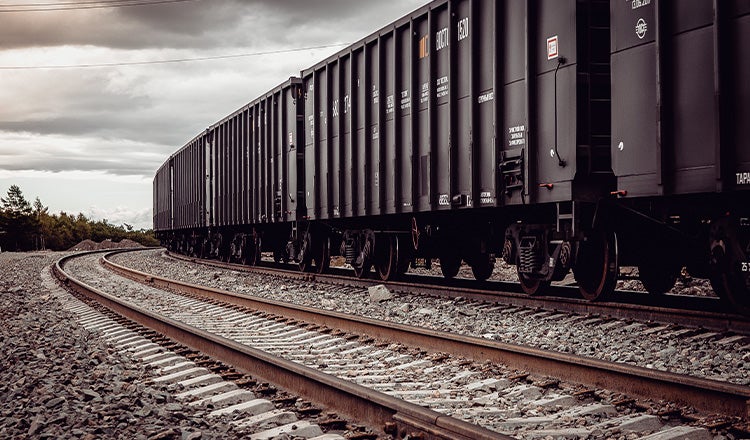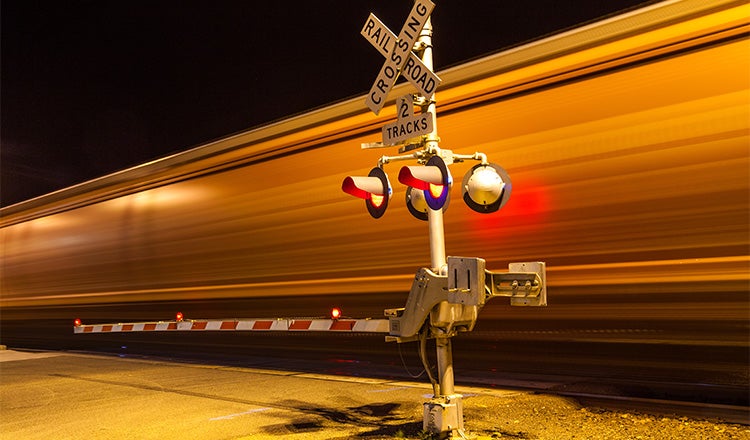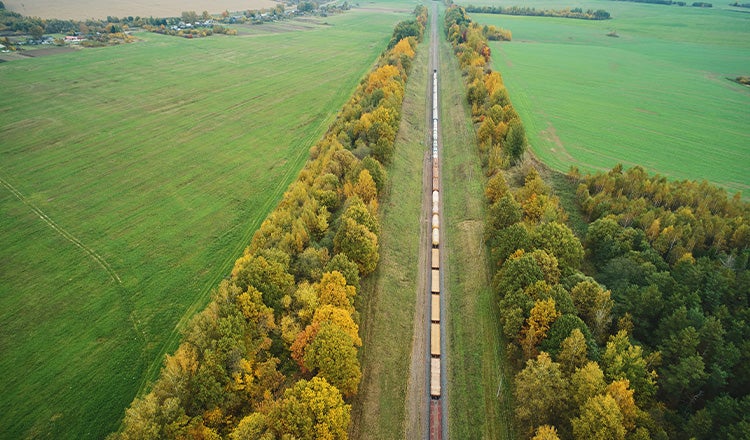
Experts Talk: Obtaining and Implementing IIJA Funds for Railroads with Cat Dobbs
Experts Talk is an interview series with technical leaders from across our transportation program.
How Freight Railroads Can Take Advantage of Record Funding to Advance Equity, Safety and Other Priorities
The Infrastructure Investment and Jobs Act offers an unprecedented influx of funding to transportation infrastructure in the United States. Freight railroads have a new opportunity to fund projects, corridors and even programs that would have been previously out of reach. In this Experts Talk interview, Cat Dobbs explains the new federal funding and how railroads can access it to make important safety improvements, position themselves for funding by incorporating equity into the process and ensure that they can successfully execute federal grant agreements once awarded.

Dobbs is a senior project manager and program strategist with HDR. She specializes in the Federal Railroad Administration’s process under the National Environmental Policy Act and other federal permitting requirements, federal partnerships, and grant monitoring, compliance and administration for freight rail projects. She spent nearly 12 years with the FRA’s Office of Program Delivery as the central team lead for the Project Management and Oversight Division. At HDR, Dobbs provides unmatched insight on how to convey project information to the FRA, offers technical expertise in the application of all federal funding requirements and compliance for rail programs and is uniquely situated to interpret federal programmatic guidance.
Q. What federal funding is available in the IIJA and federal budget and what are the implications for freight railroads?
A. The IIJA offers transformational levels of investment to benefit railroads. It created new discretionary programs including Mega and Railroad Crossing Elimination and significantly expanded eligibilities and funding amounts for legacy U.S. Department of Transportation rail programs, including the Consolidated Rail Infrastructure and Safety Improvements program. Additionally, investment in rail remains a key eligible activity for several of the flagship USDOT multi-modal programs, including INFRA — Infrastructure for Rebuilding America — and RAISE — Rebuilding American Infrastructure with Sustainability and Equity — that have significantly higher funding levels than in years past.
Industrywide there is a notion this money is for passenger rail — and while it’s true that passenger rail has received a generational level of investment through IIJA, there are also record levels of money available for freight improvements. The CRISI program is a great example — IIJA provides $1 billion each year for five years, an annual program availability nearly three times higher than the previous highest funded level.
Passenger rail opportunities set up through the revamped and well-funded Federal-State Partnership for Intercity Rail program can also be evaluated as potential freight opportunities for shared use corridors. With a few exceptions around the country, Amtrak passenger rail routes operate on freight-owned rail lines/assets, so with collaboration and vision, opportunities for passenger rail benefits can also produce meaningful shared benefits that flow to freight carriers and neighboring communities.
Additionally, the IIJA funding amounts that we see for all these programs available to fund rail improvements are the minimum federal investment that will be available; Congress has the ability to add to the funding available in any given fiscal year through its annual appropriations process. For example, IIJA appropriates $1 billion a year for CRISI for five years but authorizes an additional $1 billion a year. So there’s a potential of up to $2 billion a year if Congress decides to use the whole authorization.
All rail stakeholders should evaluate the full suite of funding options available through the USDOT programs. There is a meaningful opportunity to identify a program of transformative potential projects and partnerships that can create lasting operation and community benefits. After years of somewhat unpredictable annual appropriations for rail projects, USDOT is eager to invest in well-planned, well-developed projects that help communities, help freight operations and provide additional or improved passenger transportation options.

Q. Equity and environmental justice are major focuses in the IIJA. How can rail projects incorporate these considerations?
A. This is such a critical topic right now, both for the planning and development of projects, but also to help address the longstanding equity issues that exist in so many transportation corridors.
The traditional environmental justice approach, where we have typically considered equity-related issues, is an impact-based approach. We determine, as part of the NEPA process, if particular populations are disproportionately affected by a project. For many transportation projects this ends up being a de facto location-based analysis, with those closer to the physical improvements typically experiencing impacts.
The IIJA shifts that mentality to look at the equity opportunities and considerations through the life of the project development, including planning. There is substantial opportunity within the rail industry to integrate the participation of disadvantaged communities into the planning and development of rail projects. Many rail corridors act as physical barriers in and between communities; involving affected populations up front in the process can identify solutions, such as enhanced safety or dedicated pedestrian crossings, that can meaningfully benefit the communities affected by the project.
Privately owned rail lines don’t always engage the public as part of project development, especially if they are funding the project independently. However, when seeking federal funds, they must comply with NEPA — which requires public involvement — as well as satisfy the expectation that federal funds will lead to a public benefit. As a result, it’s more important than ever that private railroads engage the public in the design and delivery of projects so that they are well-positioned for federal funding opportunities. Often railroads operate in partnership with a state, local or other public partner, and follow that entity’s established processes. This can lend credibility and the benefit of established outreach processes/procedures, but railroads must still understand that perception and expectations can differ because the engaged public is accustomed to working with public stakeholders exclusively — the general public may not even be aware that the right-of-way or asset is privately owned.
It’s also possible for a railroad grantee to design its own project-specific outreach process and specifically and meaningfully engage the public, in concert with potential rail users or beneficiaries. Economic development projects are a great example: private infrastructure owners can act to design an engagement campaign with potential shippers, employers, etc., and ensure that the affected public has an opportunity to understand the project’s goals and potentially share in the intended benefits. For instance: if a goal of the project is to induce development by providing new rail access, railroads and private stakeholders can work with disadvantaged communities to offer meaningful career training as part of the project, to help ensure that the project delivers benefits to affected communities. You can see how this is a bit different than the traditional environmental justice “mitigate the impact” approach; it’s actually a prospective, collaborative process that seeks to share the benefits.
These are all competitive programs, and a collaborative approach to project development will better position a project for potential funding, since equity is a priority in the IIJA.
Q. Another major focus of the railroad-specific funding is safety. How can railroads use new federal funding to elevate safety?
A. Because of funding challenges, railroads and communities in the past have had to focus on maybe the one or two highest need crossings. However, that doesn’t necessarily translate to significantly enhanced corridor safety, as risks shift down-line to unimproved crossings. It’s more effective to focus on an entire corridor, but that has been out of reach for many railroads and communities.
The Railroad Grade Crossing Elimination program provides an opportunity to take a more programmatic approach to crossing safety. The level of funding available — $3 billion through IIJA alone — is sufficient to allow for operators and communities to design a comprehensive set of corridor-based improvements that enhance safety at all crossings in a given area. Not all crossings can be eliminated; but at-grade improvements, crossing closures, and grade separations can be coordinated to maximize community safety and connectivity while minimizing trespass, intrusion and incident risks.
This programmatic, corridor-based improvement approach is a long-lead planning item itself, requiring lots of up-front coordination. But the time is now. States have filed State Highway-Rail Grade Crossing Action Plans that index grade crossing priorities; this marks a fantastic, coordinated jumping-off point for stakeholders to embark on grade-crossing improvement strategies that can have transformative safety benefits.

Q. What is the process between application selection and receiving the funding?
A. This is such an important topic because selection for an award, even though it is very exciting, is absolutely not the same thing as executing the award.
Applicants should have already prepared a substantial amount of project-related documentation in advance of the Notice of Funding Opportunity and to support the grant application. While this prior work is critical to a streamlined grant obligation (signed grant agreement), it doesn’t eliminate the need for additional work to prepare for a binding funding agreement.
Rail projects carry a whole array of what I call “pre-obligation” requirements — things that must be completed, reviewed or in place before the money starts flowing. When determining these requirements, the FRA tends to fall back on whatever project elements/costs were specifically requested in the application itself — this is why that pre-NOFO and application work is so critical. For instance, if the application scope did not request funding and provide a schedule to complete NEPA, then the NEPA work would typically be considered a pre-obligation requirement, meaning the applicant would be responsible for completing the NEPA analysis for FRA review and signature before the grant can be executed. Agreements with host railroads to access and improve infrastructure are another component, that, like NEPA, can take several months to complete and typically must be completed before execution.
One important thing to note: The USDOT chooses to fund projects through its competitive grant programs, based on the description of the project and its related benefits in the application. USDOT does not select applicants to fund, allowing applicants to have discretion on project elements. The project described in the application is what FRA chooses to fund and if an applicant seeks to change the project scope, the USDOT will consider these changes very carefully to support the integrity of the competitive evaluation process. The consideration process can be time-consuming, and the applicant is not guaranteed a successful outcome.
My favorite example is from a few years ago. A well-meaning state pursued federal funding to close a high-incident grade crossing in a small community. The award was predicated on the benefits flowing to the particular community. Sounds great, right? However, after this award was selected, this community rallied against the closure of what they viewed as a critical crossing. The state listened, and discontinued plans to pursue the closure through the grant — but was subsequently not able to substitute a different crossing in for the use of the federal funds. The FRA selected the particular project for an award, not any grade crossing closure in this state. The best way to avoid a similar situation is to conduct project development coupled with stakeholder buy-in before the application is submitted.

Q. What are the FRA’s expectations of grantees?
A. What the FRA is looking for any in potential grantee is the ability to adhere to the terms and conditions of the grant agreement. Most notably, the FRA will expect the project to be delivered as scoped in the agreement itself. As mentioned before, the FRA funds projects.
There’s a very practical component to project delivery involving both building the capacity to deliver the project and the ability to manage the grant successfully. Successful grant management involves a lot of documentation and paperwork, especially as it relates to reporting and seeking financial reimbursement. The time and resource investment can be surprising for novice grantees.
Grant agreements also contain a lot of standard terms and conditions with which all federal grantees must comply. The FRA has very little ability to alter or waive any of these requirements, so it’s important for grantees to understand that these conditions must be met to remain in good standing, and that there are substantive conditions attached to federal awards that require diligent documentation and monitoring through project delivery. These conditions — compliance with federal regulations such as Buy American and labor requirements, for instance, — require detailed documentation to support project compliance. It’s certainly a worthy use of applicant time to become familiar with the requirements and ensure the delivery plan includes the appropriate time, expertise, and resources — in house or through consultant services — to honor all the terms and conditions and produce all the necessary documentation.

Advice and Inspiration
Q. How did you get involved in railroad grants?
A. I had what I call an existential crisis as a young adult. I was in law school, but quickly realized I did not want to practice. It was pretty bleak until I started taking environmental courses and became really interested in the way the transportation system fundamentally affects community development and the environment. Like so many JDs who don’t intend to practice, I went to DC. I worked for a brief time in transportation policy analysis and jumped at an opportunity in 2008 to work as a NEPA practitioner for the FRA. Never had I wanted a job so badly—it was the perfect intersection of environmental law and transportation policy. I stayed with the FRA for almost 12 years, working in NEPA, and eventually as a project manager focusing and developing and implementing grant-funded projects.
Q. What advice do you have to someone who’s just getting started on working on railroad grants?
A. Read the NOFO! FRA alum status showing here, but it’s really the most fundamental piece of advice. USDOT programs are both complex and simple — Complex because there are several requirements and components to be addressed, but remarkably simple in that the NOFO spells them out very clearly. I also recommend that potential applicants try to avail themselves of all outreach and educational opportunities offered. Both USDOT and industry groups such as American Short Line and Regional Railroad Association have some incredible content to help potential grantees — things like program specific webinars, training videos and conference presentations.
Planning early also helps. It can be challenging because it often requires an upfront investment, but there are certain components of applications that require nuanced technical analysis — not the sort of work that can be pulled together efficiently in a couple of days. With sufficient time and planning, it’s possible to scope a project to help deliver maximum benefits, which both makes the application more competitive and helps to coalesce stakeholder support.
And finally, I think specifically for the IIJA, we should all be playing the long game. IIJA is funded for five years at transformational levels. That means that for many projects, there will be multiple bites at the funding apple. Because we know IIJA programs are well funded, we have the opportunity for a truly strategic approach that combines a realistic assessment of project development —including what remains to be completed to have a competitive application — and matches it to stakeholder capital planning and USDOT programs. A little bit of up front work now, engaging in planning and forming agreements, can truly pay dividends in the future.
Each Experts Talk interview illuminates a different aspect of transportation infrastructure planning, design and delivery. Check back regularly to discover new insights from the specialized experts and thought leaders behind our award-winning, full service consulting practice.



